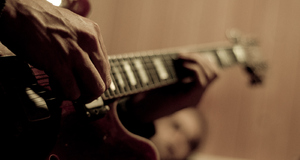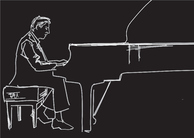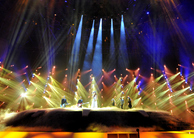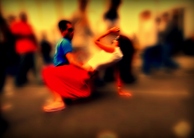The Sounds of Resistance: The Role of Music in South Africa's Anti-Apartheid Movement
By
2010, Vol. 2 No. 06 | pg. 2/2 | « A Revolution in Four-Part HarmonyThe capacity of music to forge change in South Africa is investigated in Amandla! A Revolution in Four-Part Harmony, a powerful film that focuses specifically on the ‘liberation music’ of the struggle against white domination. The word ‘Amandla’ is translated as ‘power’; within the context of the resistance, it was an affirmation of African strength and perseverance. The latter half of the title is derived from jazz pianist Abdullah Ibrahim’s observation that there has probably never been a revolution that did not use songs to give voice to its aspirations, or to unite and strengthen the morale of its adherents (Hirsch, 2002). The toppling of Apartheid may be an exceptional case, he says, “the first revolution to be conducted in four-part harmony” (Hirsh, 2002). As A.O. Scott of The New York Times notes in his review of the film, Mr. Ibrahim’s observation, “which supplies this restless, moving film with its subtitle, points to the central role that music -- in the streets, on records, in prison and in exile -- played in black South Africa's long struggle for liberation from white domination” (Scott 2003). Before discussing the significance of the view presented in this film, it is important to recognize its shortcomings as well. The flaws of a study which so narrowly focuses on the music are made clear in Grant Olwage’s book Composing Apartheid. Though he recognizes the effectiveness of the film in demonstrating the “strength of the black struggle through music,” he also asserts that the film distorts the picture of the rise and fall of apartheid by “failing to recognize the complexity of the revolutionary process.”He argues that in doing so the film suggests “potentially dangerous conclusions” for protest movements in general: First, that effective protest consists simply of “unidirectional thrusts of contention, by dissidents, against a regime”; and second, that such a strategy results in long term resolution rather than “a temporary ‘changing of the guard,’ as is usually the case with unidirectional overthrows” (Olwage 2008: pg. 262). Amandla certainly fails to tell the entire story of the struggle against Apartheid. Indeed, it fails to make clear that the toppling of the Apartheid did not solve the all of South Africa’s problems, but rather it dismantled the racial hierarchy that oppressed and ruled over the majority of the population, disallowing them from having a say over decisions that drastically affected their lives. These assertions, however, are not grounds for a complete dismissal of the film; most critically or politically minded viewers would not be led to suppose that the Africans “ ‘toyi-toyi-ed’ (1) around the Wall of Jericho (2) until it tumbled” (Olwage 263). The exposure of the situation in South Africa through such entertaining and inspirational portraits as Amandla may oversimplify the politics involved the toppling of Apartheid, but they provide a window into a world that the apartheid regime hid so well. As such, the film should be regarded not as a comprehensive picture of the revolution, or even of South African music. It would be better seen as an attempt to allow the viewer to hear and see (and perhaps feel) the power of music in forging political change, resisting oppression, strengthening community, and uniting people of different races and statuses. The reflection that music was played not only to strengthen existing communities, but to unite members of communities that were in supposed opposition to one and other is exemplified in the combining of British and African national anthems after the end of Apartheid. Although fourteen thousand people were killed in politically related incidents, South Africa’s first free election in 1994 nevertheless drew nineteen-million African voters to the polls, who unanimously voted the African National Congress into office. In the words of Nelson Mandela at his inauguration speech as the first president that a majority of South Africans elected,
Towards this end, a national anthem was composed with elements of both the African and British hymns. Before the creation of the combined anthems, “Nkosi Sikelel’ Afrika” (God Bless Africa) was the unofficial national anthem of South Africa; freedom fighter Thandi Modise describes it as a “soothing prayer” that would raise everyone’s spirit “just by listening to it” (Hirsch 2002) Even more so, the song symbolizes more than any other piece of expressive culture the struggle for African unity and liberation in South Africa. The ANC, as well as political and religious leaders across the African continent adopted the song as their anthem and as an emblem of hope and unity (Olwage 186). The combining of the two songs (Britain’s “Die Stem van Suid Afrika” coupled with “Nkosi Sikelel’ Afrika”) was a political act that actively contributed to the “construction of a community that is the new South Africa” (Nicholas Cook 1998: 75-76). Indeed, the meaning of the liberation songs emerges out of the act of performing them; it is a communal expression and movement that not only symbolizes unity, but enacts it (Cook 1998). For the lyrics to the original song, composed by a Xhosa poet in the early 19th see the index on page 23. The meaning of the word culture in the vocabulary of the ANC facilitated the mobilization of music in the service the struggle against apartheid. The word was used to refer to music, poetry, graphic arts, theatre, dance, crafts, and other “peoples’ arts”. In this sense, the strengthening and preserving of an oppressed culture becomes inherent in the act of creating art. Music was able to bridge especially powerful divides; though the songs were often used as a mode of communication that was inaccessible to police and government, they also functioned as a way of communicating across cultural and racial borders. As Sufiso Ntuli notes in Amandla,
This observation, which comments on the power of song to communicate across opposing cultural dogmas, points directly to the central role that music can play in the context of political struggle. The communal ownership of liberation songs, and the adoptability of their message within different movements, allows for them to strengthen, mobilize, and unify a community. Music does not create political change as a solitary force, as some viewers of Amandla may mistakenly conclude; rather, it is a conduit for change that stirs a community into action, expresses and calls attention to oppression, and bridges the divide between people of different cultures. In the next section I will trace the history of Apartheid through the events that created the framework for its implementation, the major figures and events of Apartheid, and the resistace that resulted. The Sounds of Resistance: Freedom Songs and the Struggle for LiberationSouth Africa’s Radio Freedom broadcasted a discussion on the liberation music of the anti-apartheid movements in which disc jockey Rude Boy Paul defines freedom songs as “liberation songs that were sun by activists and protesters that were used to mobilize and strengthen the community at large” (Hirsch 2002). Another journalist taking part in the discussion, Gail Smith, said of the music: “The freedom songs evoked a kind of pride in me. You could be standing next to a 60 year old woman who would be singing Senzenina and there would be a bond, an immediate acknowledgment of commonality in what we were about” (Hirsch 2002). This discussion points directly to music as the heart of the anti-apartheid movement. Motivated by political and social oppression, the resistance was held together and reinforced by its’ musical outpourings. Exiled Musicians: Broadcasting the Anti-Apartheid Message on a Global Scale
The Apartheid era drove its music and its musicians away from home, underground, and apart from fellow musicians, or into “the banalities of commercial music-making”. (Olwage 146) The apartheid state prohibited broadcasting of musicians who went into exile or who sang in opposition to apartheid. The government destroyed archives of black music such as African Jazz, deeming them unworthy of a remembered past. In addition, Olwage notes,
Holding up “selective pockets of resistance” as definitive of the protest movements and the liberation music fails to tell a comprehensive story. Still, there is value in focusing the lens upon exiled musicians who found commercial success abroad. Musicians such as Miriam Makeba, Hugh Masakela, Abdullah Ibrahim, and Vusi Mahlasela, who became internationally acclaimed South African voices, were able to broadcast anti-apartheid messages to an audience that ‘inziled’ musicians could not have reached under the governments’ censorship laws. The “luminary names” of exiled musicians are often held up as the key revolutionaries in the struggle (Olwage 263). This is insufficient in that the influence of musicians and activists within the country was equally vital to the struggle. It must be recognized that the music of exiled and ‘inziled’ musicians played very different roles within the body of the resistance, but equally essential to its eventual triumph. ConclusionsThe questions one faces when writing about music in the context of political struggle are numerous: Firstly, what role(s) can music play in the context of a political struggle, and how do these roles resonate in practical political terms? How is this music generated, i.e., is the music created with the intent of socio/political activism? Or does any music created by an oppressed racial group constitute freedom songs? And lastly, can music ever be separated from its political context? These questions are investigated with striking clarity in Daniel Fischlin’s and Ajay Heble’s Rebel Musics. The book outlines the diverse ways in which sonic projections have impacted human rights and social justice issues, and explores the concept of music as dissident practice, as power, and as the contradiction of “being silenced” (Fischlin 2003: pg. 10). The authors use the term “rebel musics” to describe music that functions within a political context. How this music functions politically is dependent on the situation that the artist is responding to; however, there are consistencies in the ways in which music is practical and effective as a form of political activism. It inspires community members into individual and collective action, and plays a key role in the dissemination of pertinent information through the “activation of the emotive powers that are all too often detached from the actual instruments of rights legislation” (Fischlin). Nothing in sound is intrinsically revolutionary, rebellious, or political. Simultaneously, to imagine sound as divorced from its social and political contexts, “meaningful in its abstract and metaphysical potential but irrelevant in what it has to say to the here and now of daily life,” (Fischlin 11) is to imagine sound as an abstraction, separate from its worldly consequences. As the case of South Africa exemplifies, communities give shape to music, and are in turn shaped by it. Music can serve as both an expression and a critique of culture, and as such has the power to inform, influence, and instigate change. The role of music in South Africa’s struggle to free itself from white supremacy is evident in the music itself, which responded directly to government actions. It is also evident in an examination of the resistance movements in every stage of their evolution; music was central to their communication and to their survival. Looking beyond South Africa, I speculate that music plays a key function in every struggle against socio-political oppression. From the civil rights movement’s “We Shall Overcome” to the “Rockers” music of Jamaica, it is difficult to find a resistance movement that did not utilize the power of music in some form. This recognition allows for the utilization of rebel musics in every community, in every struggle, and in every voice. For, as they say in South Africa, “the struggle is still on.” ReferencesClark, Nancy L.; Worger, William H.; South Africa: The Rise and Fall of Apartheid; Harlow; Pearson Education, 2007. Olwage, Grant; Composing Apartheid: Music For and Against Apartheid; Johannesburg; Witwatersrand University Press, 2008. Fischlin, Daniel; Heble, Ajay; Rebel Musics: Human Rights, Resistant Sounds and The Politics of Music Making; Montreal; Black Rose Books, 2003. Reddy, E.S. 1974. 'Vuyisile Mini: Worker, Poet and Martyr for Freedom' in Notes and Documents, No. 31/74, November 1974. Hirsch, Lee; Amandla! A Revolution in Four-Part Harmony; New York City; Artisan Entertainment, 2002 A. Uhlig, Mark; Apartheid In Crisis; Toronto; Random House, Inc., 1986. Cook, Nicholas; Music: A Very Short Introduction; Oxford; Oxford University Press, 1998. South African Native Affairs Commission; Report of the Commission with Annexures; Cape Town, 1905 (The SANAC Report). Huddleston, Trevor; Naught For Your Comfort; Great Britain; William Collins Sons, 1956. Lyrics“Nkosi Sikelel’ iAfrika” (In Xhosa) Nkosi, sikelel' iAfrika Lord, bless Africa “Senzeni Na?” Senzenina Senzenina What Have We Done? What have we done? Suggested Reading from Inquiries Journal
Inquiries Journal provides undergraduate and graduate students around the world a platform for the wide dissemination of academic work over a range of core disciplines. Representing the work of students from hundreds of institutions around the globe, Inquiries Journal's large database of academic articles is completely free. Learn more | Blog | Submit Latest in Music |


















